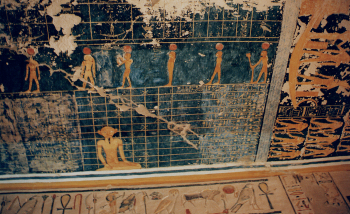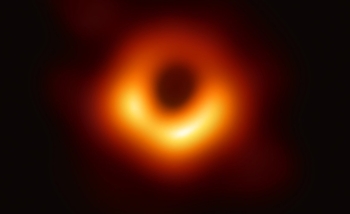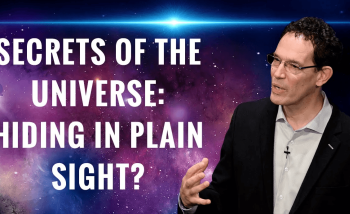Never mind the big bang; in the beginning was the vacuum. The vacuum simmered with energy (variously called dark energy, vacuum energy, the inflation field, or the Higgs field). Like water in a pot, this high energy began to evaporate – bubbles formed.
Each bubble contained another vacuum, whose energy was lower, but still not nothing. This energy drove the bubbles to expand. Inevitably, some bubbles bumped into each other. It’s possible some produced secondary bubbles. Maybe the bubbles were rare and far apart; maybe they were packed close as foam.
But here’s the thing: each of these bubbles was a universe. In this picture, our universe is one bubble in a frothy sea of bubble universes.
That’s the multiverse hypothesis in a bubbly nutshell.
It’s not a bad story. It is, as scientists say, physically motivated – not just made up, but rather arising from what we think we know about cosmic inflation.
Cosmic inflation isn’t universally accepted – most cyclical models of the universe reject the idea. Nevertheless, inflation is a leading theory of the universe’s very early development, and there is some observational evidence to support it.
Inflation holds that in the instant after the big bang, the universe expanded rapidly – so rapidly that an area of space once a nanometer square ended up more than a quarter-billion light years across in just a trillionth of a trillionth of a trillionth of a second. It’s an amazing idea, but it would explain some otherwise puzzling astrophysical observations.
Inflation is thought to have been driven by an inflation field – which is vacuum energy by another name. Once you postulate that the inflation field exists, it’s hard to avoid an “in the beginning was the vacuum” kind of story. This is where the theory of inflation becomes controversial – when it starts to postulate multiple universes.
Proponents of the multiverse theory argue that it’s the next logical step in the inflation story. Detractors argue that it is not physics, but metaphysics – that it is not science because it cannot be tested. After all, physics lives or dies by data that can be gathered and predictions that can be checked.
That’s where Perimeter Associate Faculty member Matthew Johnson (cross-appointed at York University) comes in. Working with a small team that also includes Perimeter Faculty member Luis Lehner, Johnson is working to bring the multiverse hypothesis firmly into the realm of testable science.
“That’s what this research program is all about,” he says. “We’re trying to find out what the testable predictions of this picture would be, and then going out and looking for them.”
Specifically, Johnson has been considering the rare cases in which our bubble universe might collide with another bubble universe. He lays out the steps: “We simulate the whole universe. We start with a multiverse that has two bubbles in it, we collide the bubbles on a computer to figure out what happens, and then we stick a virtual observer in various places and ask what that observer would see from there.”
Simulating the whole universe – or more than one – seems like a tall order, but apparently that’s not so.
“Simulating the universe is easy,” says Johnson. Simulations, he explains, are not accounting for every atom, every star, or every galaxy – in fact, they account for none of them.
“We’re simulating things only on the largest scales,” he says. “All I need is gravity and the stuff that makes these bubbles up. We’re now at the point where if you have a favourite model of the multiverse, I can stick it on a computer and tell you what you should see.”
That’s a small step for a computer simulation program, but a giant leap for the field of multiverse cosmology. By producing testable predictions, the multiverse model has crossed the line between appealing story and real science.
In fact, Johnson says, the program has reached the point where it can rule out certain models of the multiverse: “We’re now able to say that some models predict something that we should be able to see, and since we don’t in fact see it, we can rule those models out.”
For instance, collisions of one bubble universe with another would leave what Johnson calls “a disk on the sky” – a circular bruise in the cosmic microwave background. That the search for such a disk has so far come up empty makes certain collision-filled models less likely.
Meanwhile, the team is at work figuring out what other kinds of evidence a bubble collision might leave behind. It’s the first time, the team writes in their paper, that anyone has produced a direct quantitative set of predictions for the observable signatures of bubble collisions. And though none of those signatures has so far been found, some of them are possible to look for.
The real significance of this work is as a proof of principle: it shows that the multiverse can be testable. In other words, if we are living in a bubble universe, we might actually be able to tell.
– Erin Bow
FURTHER EXPLORATION
- Check out some of Johnson et al.’s papers about simulating bubble collisions using numerical relativity on arXiv:
- “Determining the outcome of cosmic bubble collisions in full General Relativity”
- “Simulating the universe(s): from cosmic bubble collisions to cosmological observables with numerical relativity”
- “Simulating the universe(s) II: phenomenology of cosmic bubble collisions in full General Relativity” - Read Johnson and company’s work pertaining to observational tests of eternal inflation on arXiv:
- “Towards observable signatures of other bubble universes”
- “First Observational Tests of Eternal Inflation”
- “Hierarchical Bayesian Detection Algorithm for Early-Universe Relics in the Cosmic Microwave Background” - Read a recent blog post about bubble collisions from University College London
About PI
Perimeter Institute is the world’s largest research hub devoted to theoretical physics. The independent Institute was founded in 1999 to foster breakthroughs in the fundamental understanding of our universe, from the smallest particles to the entire cosmos. Research at Perimeter is motivated by the understanding that fundamental science advances human knowledge and catalyzes innovation, and that today’s theoretical physics is tomorrow’s technology. Located in the Region of Waterloo, the not-for-profit Institute is a unique public-private endeavour, including the Governments of Ontario and Canada, that enables cutting-edge research, trains the next generation of scientific pioneers, and shares the power of physics through award-winning educational outreach and public engagement.
You might be interested in


Spiralling light from M87’s supermassive black hole reveals strong magnetic fields
November 8, 2023
